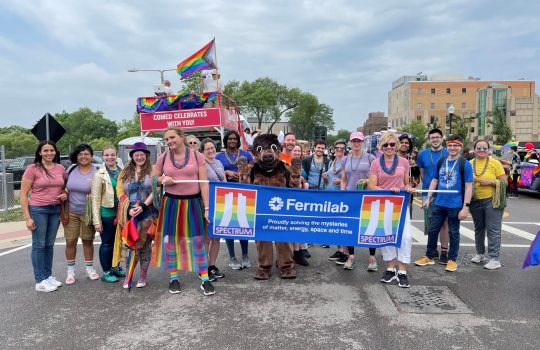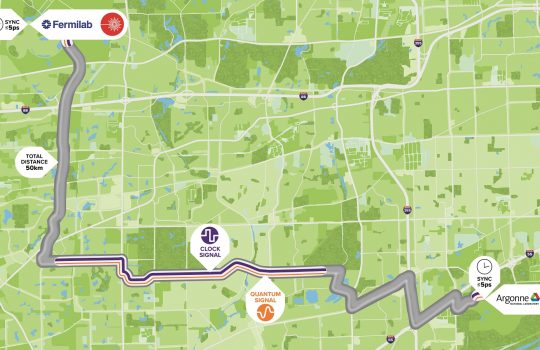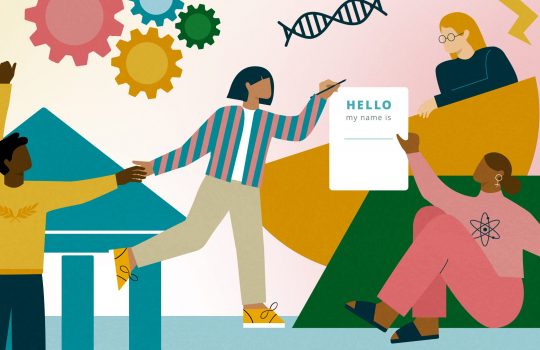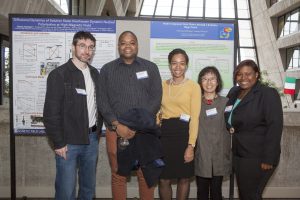
NSBP members presented their research at a poster session during the NSBP’s fall workshop, hosted by Fermilab in 2016. From left: Matthew Buckley, Rutgers University; Gopolang Mohlabeng, University of Kansas; Katrina Miller, University of Chicago; Young-Kee Kim, University of Chicago; Adelia Clarke, Pacific Northwest National Laboratory. Photo: Marty Murphy
Summer is coming to an end, and Fermilab’s summer students are scattering back to their universities.
And at about this time 15 years ago, a lucky few Fermilab students would have been selected to give presentations on their summer work at the annual conference for the National Society of Black Physicists (NSBP).
Fermilab’s sending students to NSBP conferences was a continuation of a long-standing relationship between the laboratory and the society—a connection that reached back to the early days of both institutions in 1974.
Most recently, Fermilab hosted NSBP’s fall workshop in 2016.
And now, instead of Fermilab sending students to NSBP conferences, NSBP will send students to Fermilab: At the fall workshop, NSBP president Renee Horton announced an undergraduate academic partnership that will see two NSBP student members joining Fermilab’s Summer Internships in Science and Technology (SIST) program, starting in 2018.
NSBP exists to promote the professional well-being of African-American physicists and physics students within society at large. When it was founded in 1977, NSBP was a way for black physicists to connect — and at the time, they were few and far between. A roster compiled in 1980 by NSBP of every black person with a physics degree in the world was only 200 entries long.
Three years before NSBP was formed, Fermilab had sponsored a Conference on Minority Physicists. Twenty-five non-Fermilab attendees joined with Fermilab officials and scientists to look for new ways to increase the number of minority scientists.
“Visitors told Edwin Goldwasser, an organizer of the event, that the opportunity for minority physicists to come together to discuss problems unique to them was afforded only by Fermilab at this time,” said a 1974 article about the conference published in Fermilab’s newsletter The Village Crier.
“Ed Goldwasser had significant perspective with regard to how bringing minority physicists to Fermilab was important to the laboratory and how important it was to the nation,” said Herman White, senior scientist at Fermilab. When this conference occurred, White had been at the laboratory only four weeks.
The conference attendees later helped officially establish NSBP with help from conference organizers such as James Davenport, who coordinated Fermilab’s summer student programs from 1971 to 2014 and served as NSBP’s first secretary-treasurer.
White was instrumental in bringing NSBP to Fermilab in 1981.
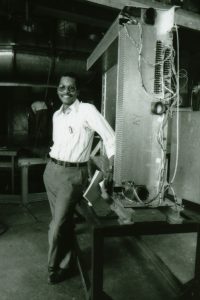
In 1981, Herman White was instrumental in bringing the National Society of Black Physicists to Fermilab. Photo: Fermilab
“NSBP had an annual Day of Scientific Lectures, which was usually held at historically black colleges and universities, and going outside of that particular venue was quite new,” White said. “I thought out of the box, so to speak, and suggested to the leadership of NSBP that we have it at Fermilab.”
Fermilab hosted the conference and co-sponsored it with Argonne National Laboratory, turning the Day of Scientific Lectures into NSBP’s first annual conference, with international speakers and published proceedings.
“One of the other pioneering things that we did at this conference was to invite students—high school and college,” White said. “It was 1981, so besides Saturday Morning Physics, the idea of actually bringing high school students into a real, organized physics gathering was uncommon.” Saturday Morning Physics is a long-standing Fermilab program that gives local high school students the opportunity to hear physics lectures from top scientists and tour areas of the lab.
Students at the NSBP conference would become a connecting thread between the society and Fermilab many years later. Starting in 2002, as a means of supporting the NSBP conference, summer students from Fermilab were selected to go to the conference and present their research.
“Sending students to the conference in support of the work they’d done at Fermilab was one of those brilliant ideas of how the lab could stay connected to improving and helping diversity,” White said. “But it also emphasized why the lab exists: to do the science, to promote the science and to provide people with an opportunity to engage in the science.”
The tradition of improving diversity by providing the opportunity for future physicists to engage in science will continue with internship opportunities for NSBP summer students in the SIST program.
“It’s a great collaboration and a logical partnership,” said Sandra Charles, Fermilab’s talent acquisition, diversity and inclusion manager. “By maintaining a strong tie with NSBP, we affirm our commitment to their mission, support the aspirations of their membership, and provide valuable research opportunities which promote the national laboratory system as a place to advance their scientific careers.”

